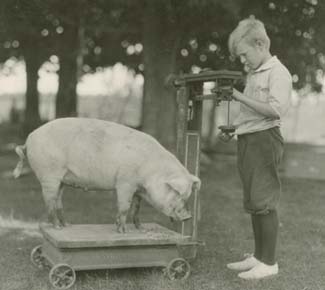 |
 |
| current issue |  | past issues |  | send a letter/news |  | address update |  | advertise |  | about us |  | alumni home |
On Ben's Farm
|
Methods Class
Reaching out to farmers with the latest ideas By Mylinda Woodward '97 Also read a longer version of this story |
Easy to print version |

|
Jaws dropped in amazement as spectators watched 19-year-old Helen Bernaby '30 rhythmically swing her scythe through the alfalfa field, leaving behind long swaths of hay—as well as 11 male competitors—as she won the first hand-mowing competition at the 1926 Farmers' and Home-Makers' Week in Durham. Newspapers ran the story of the "hayfield heroine," and when she began freshman year that fall, she arrived with a certain amount of celebrity status.
Helen's feat was probably not very surprising to her family. Like most of the participants in Farmer's Week, the Bernabys of North Danville, N.H., considered their farm both home and livelihood. Everyone was expected to help with chores, and it was not unusual to find Helen haying the fields (albeit with a mowing machine, not a scythe). On her college application, she wrote the reason she wanted to go to college was "to train for extension work [and] to be able to help people."
As a land-grant college, UNH is charged with helping people, a service otherwise known as outreach. Early on, the college offered exhibits, lectures, bulletins and, beginning in 1909, the Farmers' Institute "One-Week Course." Designed for those "who wish to get some new ideas concerning the latest and most approved methods of farming operations and household work," the course's only cost to participants was lodging, if needed. And, attendees were assured, there would be no exams!
The N.H. Agricultural Experiment Station, established in 1887, expanded its outreach efforts to the entire rural community. Perhaps one of the most important audiences was future farmers of the state, and in 1914, Boys' and Girls' Clubs (now 4-H) were introduced. The boys competed against each other to see who could grow the most corn and potatoes; the prize for the state champion was a four-year scholarship. The girls grew tomatoes and string beans.
At a Farmers' Week, the college's own livestock, fields, orchards and woodlots were used for demonstrations. Attendees could see all the latest labor-saving devices, from the newest tractors to electric washing machines, or watch ditches being blasted with dynamite. But it was not all work. Organizers realized that for many farm families, a week such as this might be their only opportunity for a few days' vacation. Friday afternoons and evenings were reserved for singing, spelling bees, storytelling and, beginning in 1916, moving pictures. Later, recreational activities expanded to include picnics, parades, one-act play competitions, horseshoe-pitching tournaments, baseball games and swimming. About 5,000 people attended the "Farm Follies" of 1925.
The last Farm and Home Days event was held in 1953—the demographics and self-image of the state had changed. By then heavily industrialized, New Hampshire was no longer primarily agricultural.
When Benjamin Thompson willed his Durham farmland for an agricultural school, there were more than 30,000 farms in the state. Now there are fewer than 5,000. The efforts by the College of Life Sciences and Agriculture, the Experiment Station and Cooperative Extension to support and promote agriculture in the state may be even more important today. In the words of a bumper sticker seen recently on campus: "No Farms, No Food." ~
blog comments powered by Disqus

